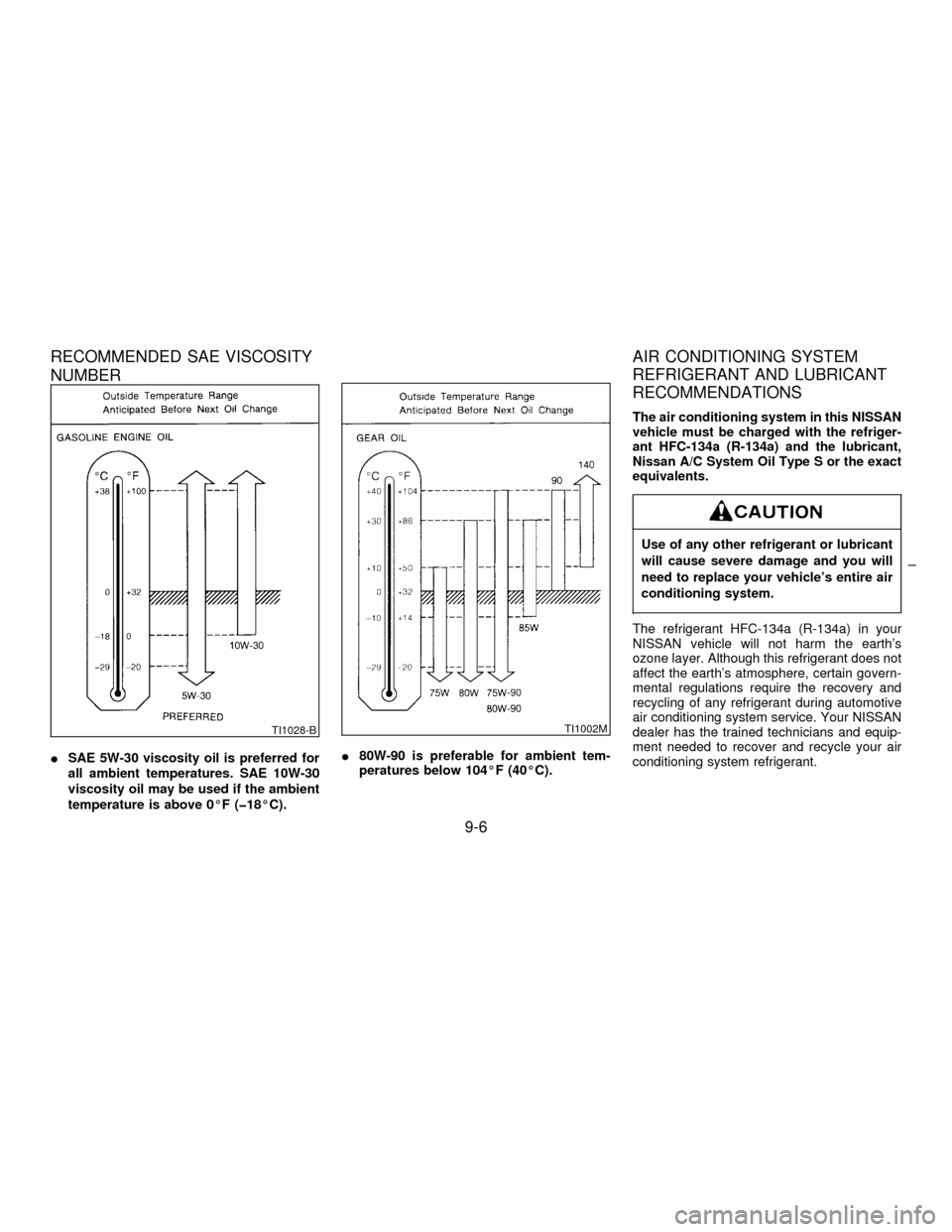1997 NISSAN MAXIMA oil temperature
[x] Cancel search: oil temperaturePage 193 of 215

RECOMMENDED SAE VISCOSITY
NUMBER
ISAE 5W-30 viscosity oil is preferred for
all ambient temperatures. SAE 10W-30
viscosity oil may be used if the ambient
temperature is above 0ÉF (þ18ÉC).I80W-90 is preferable for ambient tem-
peratures below 104ÉF (40ÉC).
AIR CONDITIONING SYSTEM
REFRIGERANT AND LUBRICANT
RECOMMENDATIONS
The air conditioning system in this NISSAN
vehicle must be charged with the refriger-
ant HFC-134a (R-134a) and the lubricant,
Nissan A/C System Oil Type S or the exact
equivalents.
Use of any other refrigerant or lubricant
will cause severe damage and you will
need to replace your vehicle's entire air
conditioning system.
The refrigerant HFC-134a (R-134a) in your
NISSAN vehicle will not harm the earth's
ozone layer. Although this refrigerant does not
affect the earth's atmosphere, certain govern-
mental regulations require the recovery and
recycling of any refrigerant during automotive
air conditioning system service. Your NISSAN
dealer has the trained technicians and equip-
ment needed to recover and recycle your air
conditioning system refrigerant.
TI1028-BTI1002M
9-6
Z01.2.1/A32-DX
Page 204 of 215

wheels and applying the parking brake,
transmission damage could occur.
IWhen going down a hill, shift into a lower
gear and use the engine braking effect.
When ascending a long grade, downshift
the transmission to a lower gear and reduce
speed to reduce chances of engine over-
loading and/or overheating.
IIf the engine coolant rises to an extremely
high temperature when the air conditioning
system is on, turn off the air conditioner.
Coolant heat can be additionally vented by
opening the windows, switching the fan
control to high and setting the temperature
control to the ªHOTº position.
ITrailer towing requires more fuel than nor-
mal circumstances.
IAvoid towing a trailer for the first 500 miles
(800 km).
IHave your vehicle serviced more often than
at intervals specified in the recommended
Maintenance Schedule.
IWhen making a turn, your trailer wheels will
be closer to the inside of the turn than your
vehicle wheels. To compensate for this,
make a larger than normal turning radius
during the turn.ICrosswinds and rough roads will adversely
affect vehicle/trailer handling, possibly
causing vehicle sway. When being passed
by larger vehicles, be prepared for possible
changes in crosswinds that could affect
vehicle handling. If swaying does occur,
firmly grip the steering wheel, steer straight
ahead, and immediately (but gradually) re-
duce vehicle speed. This combination will
help stabilize the vehicle. Never increase
speed.
IBe careful when passing other vehicles.
Passing while towing a trailer requires con-
siderably more distance than normal pass-
ing. Remember the length of the trailer
must also pass the other vehicle before you
can safely change lanes.
ITo maintain engine braking efficiency and
electrical charging performance, do not use
fifth gear (manual transmission) or over-
drive (automatic transmission).
IAvoid holding the brake pedal down too
long or too frequently. This could cause the
brakes to overheat, resulting in reduced
braking efficiency.
When towing a trailer, change oil in the
transmission more frequently.
See the Maintenance schedule.
9-17
Z01.2.1/A32-DX
Page 210 of 215

10 Index
A
Air bag system (See ªSupplemental restraint
systemº) .......................................................... 2-17
Air bag warning light (See ªSupplemental air bag
warning lightº) ................................................. 2-22
Air cleaner filter ............................................... 7-17
Air conditioner
Air conditioner operation ............................. 3-5
Air conditioner specification label.............. 9-12
Automatic air conditioner (If so equipped) .. 3-9
Air conditioning system refrigerant and lubricant
recommendations ............................................. 9-6
Air flow chart ..................................................... 3-6
Antenna........................................................... 3-28
Anti-lock brake system (ABS) (If so equipped) .. 4-
18
Audio main operation ...................................... 3-23
Automatic
Automatic air conditioner (If so equipped) .. 3-9
Automatic transmission fluid ..................... 7-10
Driving with automatic transmission............ 4-7
Avoiding collision and rollover .......................... 4-3
B
Battery............................................................. 7-13
Battery replacement.......................................... 2-7
Before starting the engine ................................ 4-6Brake
Anti-lock brake system (ABS) (If so
equipped)................................................... 4-18
Brake and clutch fluid................................ 7-12
Brake booster ............................................ 7-21
Brake pedal ............................................... 7-20
Brake system............................................. 4-17
Brake wear indicators ........................ 1-9, 7-20
Parking brake ................................... 4-12, 7-19
Break-in schedule ........................................... 4-15
C
Capacities and recommended fuel/lubricants... 9-2
Cargo (See ªVehicle loading
information) ..................................................... 9-13
Cassette tape player operation....................... 3-25
CB radio or car phone .................................... 3-29
Changing
Changing engine coolant ............................ 7-6
Changing engine oil .................................... 7-8
Changing oil filter ........................................ 7-9
Checking engine coolant level .......................... 7-5
Checking engine oil level .................................. 7-7
Child restraints for infants and small children .... 2-
31
Child safety rear door lock................................ 2-3
Cigarette lighter and ash trays ....................... 1-17
Cleaning exterior and interior ........................... 6-2
Clearing the programming information ........... 1-26Clock ............................................................... 1-22
Clutch pedal .................................................... 7-21
Cold weather driving ....................................... 4-19
Compact disc (CD) player operation .............. 3-26
Controls............................................................. 3-3
Coolant
Changing engine coolant ............................ 7-6
Checking engine coolant level .................... 7-5
Engine coolant temperature gauge ............. 1-4
Corrosion protection ......................................... 6-5
Cruise control.................................................. 4-13
Cup holder ...................................................... 1-19
D
Defogger switch
Rear window and outside mirror defogger
switch......................................................... 1-13
Dimensions and weights ................................... 9-9
Door lock operation .......................................... 2-6
Door locks ......................................................... 2-2
Door unlock operation ...................................... 2-6
Drinking alcohol/drugs and driving ................... 4-4
Drive belts ....................................................... 7-15
Driving
Cold weather driving ................................. 4-19
Drinking alcohol/drugs and driving .............. 4-4
Driving with automatic transmission............ 4-7
Driving with manual transmission ............. 4-10
Z01.2.1/A32-DX
Page 211 of 215

Precautions when starting and driving ........ 4-2
E
Economy hints ................................................ 4-15
Emission control information label .................. 9-11
Emission control system warranty .................. 9-19
Engine ............................................................... 9-8
Before starting the engine ........................... 4-6
Changing engine coolant ............................ 7-6
Changing engine oil .................................... 7-8
Checking engine coolant level .................... 7-5
Checking engine oil level ............................ 7-7
Engine coolant temperature gauge ............. 1-4
Engine cooling system ................................ 7-5
Engine oil..................................................... 7-7
Engine oil and oil filter
recommendation .......................................... 9-4
Engine serial number ................................ 9-11
Starting the engine ...................................... 4-6
Exhaust gas (Carbon monoxide) ...................... 4-2
Explanation of maintenance items.................. 8-10
F
Flat tire .............................................................. 5-2
Fluid
Automatic transmission fluid ..................... 7-10
Brake and clutch fluid................................ 7-12
Power steering fluid................................... 7-11
Window washer fluid ................................. 7-12
FM/AM radio with cassette player .................. 3-12
FM-AM radio with cassette player .................. 3-16FM-AM radio with cassette player and
compact disc player ........................................ 3-22
F.M.V.S.S. certification label........................... 9-11
Foldable outside mirrors ................................. 2-39
Front fog light switch (If so equipped) ............ 1-15
Front personal light ......................................... 1-23
Fuel
Capacities and recommended
fuel/lubricants .............................................. 9-2
Fuel filler cap ............................................. 2-10
Fuel filler lid lock ....................................... 2-10
Fuel gauge .................................................. 1-5
Fuel recommendation.................................. 9-2
Fuses .............................................................. 7-21
Fusible links .................................................... 7-23
G
Gauge
Engine coolant temperature gauge ............. 1-4
Fuel gauge .................................................. 1-5
Meters and gauges ..................................... 1-3
General maintenance ....................................... 8-3
Glove box lock .................................................. 2-8
H
Hazard warning flasher switch........................ 1-16
Head restraint ................................................. 2-15
Headlight and turn signal switch..................... 1-14
Headlights ....................................................... 7-23
Heated seats (If so equipped) ........................ 1-16
Heater operation ............................................... 3-4Hood release .................................................... 2-8
I
If your vehicle is ever stolen ........................... 1-26
If your vehicle overheats .................................. 5-9
Ignition switch ................................................... 4-4
Injured persons ............................................... 2-26
Inside mirror .................................................... 2-40
Installing license plate .................................... 9-12
Instrument brightness control ......................... 1-15
Integrated HomeLink
transmitter
(If so equipped).......................................... 1-24
Interior light ..................................................... 1-22
J
Jump starting ........................................... 5-7, 7-14
K
Key .................................................................... 2-2
L
License plate
Installing license plate ............................... 9-12
Light
Front fog light switch (If so
equipped)................................................... 1-15
Front personal light ................................... 1-23
Headlight and turn signal switch ............... 1-14
Headlights.................................................. 7-23
Interior light................................................ 1-22
10-2
Z01.2.1/A32-DX
Page 214 of 215

Recommended fuel:
Unleaded premium gasoline with an octane
rating of at least 91 AKI (Anti-Knock Index)
number (Research octane number 96).
If unleaded premium gasoline is not avail-
able, unleaded regular gasoline with an
octane rating of at least 87 AKI (Research
octane number 91) can be used.
However, for maximum vehicle perfor-
mance, the use of unleaded premium gaso-
line is recommended.
Using a fuel other than that specified
could adversely affect the emission con-
trol devices and systems, and could
also affect the warranty coverage.
Under no circumstances should a
leaded gasoline be used, since this will
damage the three way catalyst.
For further details such as gasohol, see ªFuel
recommendationº in the ªTechnical and con-
sumer Informationº section.
Recommended engine oil
specifications:
IAPI SG or SH and Energy Conserving II
IAPI Certification Mark
ISAE 10W-30 viscosity oil is preferred for
ambient temperatures above 0ÉF (þ18ÉC).
See ªEngine oil and oil filter recommendationº
in the ªTechnical and consumer informationº
section.
Tire cold pressure:
See tire placard affixed to the center console
lid.
Recommended new vehicle
break-in procedure:
During the first 1,000 miles (1,600 km) of
vehicle use, follow the recommendations out-
lined in the ªBREAK-IN SCHEDULE Informa-
tion found in the ªStarting and drivingº section
of this Owner's Manual. Follow these recom-
mendations for the future reliability and
economy of your new vehicle. Failure to follow
these recommendations may result in vehicle
damage or shortened engine life.(page)
IIn case of emergency .......................... 5-1
(Flat tire, engine will not start,
overheating, towing)
IHow to start the engine ....................... 4-1
IMaintenance schedule......................... 8-1
IDo-it-yourself operations .................... 7-1
ITechnical and consumer
information ........................................... 9-1
GAS STATION INFORMATION QUICK REFERENCE
Z01.2.1/A32-DX